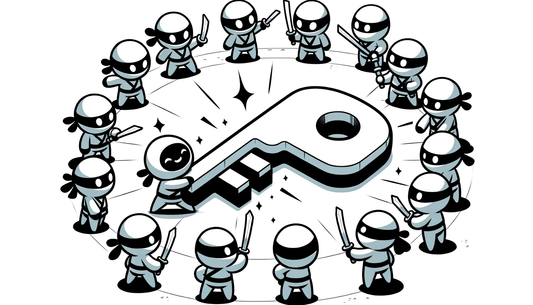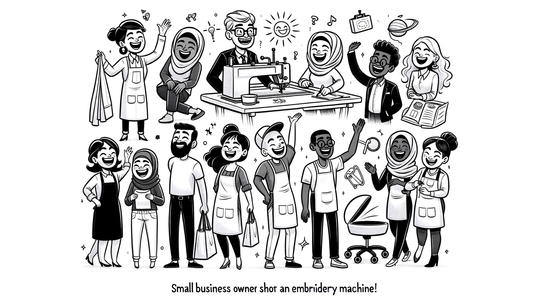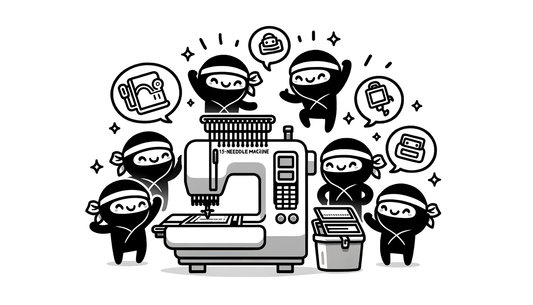
Embroidery Machine Setup: A Beginner's Guide
Share
Embarking on your embroidery journey is exciting, but setting up your new machine can feel daunting. This guide simplifies the process, ensuring your first stitches are a success. Whether you're a hobbyist or a small business owner eager to create custom designs, this step-by-step approach will have you up and running in no time. And if you're looking for a reliable, user-friendly machine to get started, consider the Embro Ninjas NinjaStarter, known for its ease of setup and impressive capabilities. You can learn more about it at: NinjaStarter
Unboxing and Initial Assembly: Preparing Your Workspace
Before diving in, preparation is key.
- Clear a Large Workspace: Make sure you have enough room to comfortably lay out all machine parts and accessories.
- Unpack and Inventory: Carefully remove the main embroidery machine unit and all accessories.
- Accessory Checklist: Verify you have embroidery hoops, needles, power cords, and instruction manuals.
- Confirm Parts: Compare the contents against the manufacturer's inventory list to avoid surprises.
Now, let's assemble:
- Attach the Embroidery Arm: After removing any accessory tray, slide the embroidery unit onto the free arm until it clicks into place.
- Set Up Spool Holders: Follow your model's instructions for proper setup.
- Component Familiarization: Take a moment to familiarize yourself with each part.
If you're looking for customizable options (embroidery area sizes), Embro Ninjas' product may be a perfect fit for your needs. See more at: 👉 Customize Your Embroidery Machine
Threading Process and Tension Adjustment: Achieving Balanced Stitches
Threading correctly is crucial for stitch quality.
- Threading the Machine: Consult your manual for specific threading instructions, using the same thread for both threading and tests.
- Thread Guidance: Place the spool on the holder and guide the thread through all indicated guides, tension disks, and the needle.
Bobbin setup is equally important:
- Bobbin Setup: Wind the bobbin and insert it correctly into the bobbin case.
- Bobbin Tension: Aim for a tension range of 25–35 grams, adjustable with a small screwdriver. Test and adjust on scrap fabric.
- Upper Thread Tension: Start with the default setting recommended in your manual.
-
Tension Testing: Run a sample stitch and adjust:
- Increase tension if bobbin thread shows on top.
- Decrease tension if the upper thread is too tight.
If you are looking for a machine with TAJIMA Type thread tension, consider the Embro Ninjas NinjaStarter, learn more: 👉 NinjaStarter
Maintenance Tip: Regularly clean lint from the bobbin case to prevent jams.
First Test Run Procedure: Putting It All Together
- Power Up and Calibrate: Plug in the machine and turn it on. Calibrate as prompted, ensuring nothing obstructs the embroidery arm.
- Load a Simple Design: Choose a design via USB or internal memory.
- Hoop Your Fabric: Loosen the hoop screw, place fabric (with stabilizer) between the rings, and tighten until taut.
- Attach the Hoop: Secure the hoop to the embroidery arm.
- Start Stitching: Lower the presser foot and select the design. Press start and monitor the process.
- Inspect the Quality: Check for even stitches and proper thread balance. Adjust tension if needed.
Embro Ninjas machines, are celebrated for intuitive controls! If you would like a demo of Embro Ninjas NinjaStarter, schedule a meeting today! 👉 Schedule a Meeting
Troubleshooting Common Setup Issues: Addressing Potential Problems
Encountering issues? Here's how to tackle them:
- Machine Does Not Power On: Verify the power cord connection and switch.
- Embroidery Arm Issues: Ensure the arm isn't blocked and is correctly attached.
- Hoop Problems: Use the correct hoop and ensure fabric is tightly hooped.
- Thread Breakage: Re-thread both upper and bobbin threads, and adjust tension.
- Needle/Presser Foot Errors: Install the correct needle and foot, adjusting height as needed.
- Design Loading Failures: Confirm the file format is compatible and properly loaded.
If you're still struggling with setup or operation, Embro Ninjas offers unmatched one-on-one concierge service to help you get the most out of your machine. For more information on what to expect during a virtual demo, visit: 👉 Virtual Demo Information
Specific Recommendations and Best Practices: Enhancing Your Embroidery
- Use Quality Materials: Opt for quality thread and the right stabilizer.
- Test on Scrap Fabric: Fine-tune tension and technique before final projects.
- Regular Maintenance: Clean the machine, especially the bobbin area.
- Consult the Manual: Read the full instruction manual for your model.
- Stay Organized: Keep accessories readily accessible.
If you're a small business, creative enthusiast, or entrepreneur looking for affordable, high-quality embroidery solutions, Embro Ninjas could be the perfect partner. Backed by 30+ years of experience and direct-from-factory pricing, Embro Ninjas empowers creativity and growth. You can also check the company story at 👉 Company Story
By following these steps, you'll be well-equipped to set up your embroidery machine and create beautiful, professional-looking designs.
What people also ask?
Question: Why is stabilizer important for embroidery?
Answer: Stabilizer provides support to the fabric during the embroidery process, preventing stretching, puckering, and distortion of the design.
Stabilizer acts as a foundation that keeps the fabric taut and in place while the needle penetrates it repeatedly. Different types of stabilizers are available, such as tear-away, cut-away, and wash-away, each suited for different fabric types and embroidery projects. Using the correct stabilizer ensures clean, crisp designs and prevents damage to the fabric. For instance, delicate fabrics benefit from soft, wash-away stabilizers, while heavier fabrics require more robust cut-away stabilizers. Not using a stabilizer can lead to unprofessional-looking results and potential damage to your project. You can also find additional helpful guides at 👉 Helpful Guides
Question: How often should I service my embroidery machine?
Answer: You should service your embroidery machine at least once a year, or more frequently if you use it heavily, to maintain its performance and longevity.
Regular servicing includes cleaning, lubricating, and adjusting various parts to ensure smooth operation. Neglecting maintenance can lead to decreased stitch quality, increased thread breakage, and potential mechanical issues. Depending on usage, you might need to clean the bobbin area every few projects and have a professional service done annually. Proper maintenance not only extends the life of your machine but also ensures consistent and high-quality embroidery results.
Question: What are common signs that my embroidery machine needs tension adjustment?
Answer: Common signs include looping stitches on the top or bottom of the fabric, thread breaks, uneven stitch density, and visible bobbin thread on the top surface.
These issues indicate that the upper and lower thread tensions are not balanced correctly. Looping stitches suggest that the tension is too loose, while thread breaks can result from excessive tension. To diagnose the problem, examine the stitches closely and adjust the tension knobs accordingly. Always make small adjustments and test on scrap fabric until the stitches appear balanced and uniform. Addressing tension issues promptly prevents further problems and ensures professional-looking embroidery. If you're considering upgrading to a new machine with advanced tension control, explore the reliable, high-quality components and advanced engineering that are standard in our products.
Summary: Properly setting up your embroidery machine ensures a smooth start and beautiful results. Attention to detail in assembly, threading, and tension adjustment is critical for achieving balanced stitches and preventing common issues. With the right approach, you can create stunning embroidered designs.


